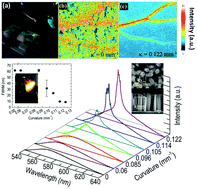A curvature-tunable random laser†
Abstract
The application of random lasers has been restricted due to the absence of a well-defined resonant cavity, as the lasing action mainly depends on multiple light scattering induced by intrinsic disorders of the laser medium to establish the required optical feedback that hence increases the difficulty in efficiently tuning and modulating random lasing emissions. This study investigated whether the transport mean free path of emitted photons within disordered scatterers composed of ZnO nanowires is tunable by a curvature bending applied to the flexible polyethylene terephthalate (PET) substrate underneath, thereby creating a unique light source that can be operated above and below the lasing threshold for desirable spectral emissions. For the first time, the developed curvature-tunable random laser is implemented for in vivo biological imaging with much lower speckle noise compared to the non-lasing situation through simple mechanical bending, which is of great potential for studying the fast-moving physiological phenomenon such as blood flow patterns in mouse ear skin. It is expected that the experimental demonstration of the curvature-tunable random laser can provide a new route to develop disorder-based optoelectronic devices.



 Please wait while we load your content...
Please wait while we load your content...